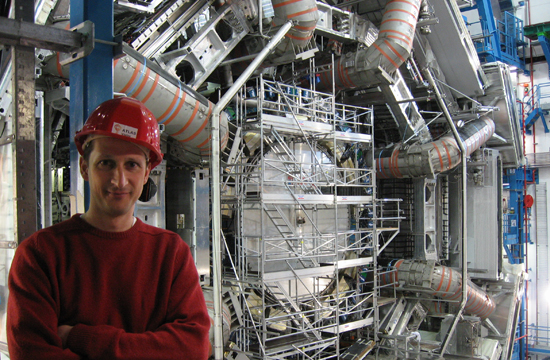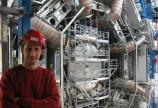UVic physicists bask again in Nobel glory

The Large Hadron Collider (LHC) near Geneva is relatively quiet right now, because the giant underground machine is offline until 2015. Of course, scientists would be quick to point out that even when protons are streaming through the circular tunnel, the subatomic collisions of trillions of particles would still not be audible.
The excitement over the discovery of the elusive Higgs boson particle was deafening last summer. And now, the 2013 Nobel Prize in Physics has gone to two of the original theorists—Francois Englert and Peter Higgs—who helped predict this particular aspect of quantum physics. Two decades ago, the original UVic group brought Canadians into the international LHC project and its hunt for the Higgs.
More on the LHC
“The discovery of the Higgs boson, which plays a unique role in the structure of matter, is truly fundamental to our understanding of the world,” explains Dr. Robert Kowalewski, chair of UVic’s Department of Physics and Astronomy and one of dozens of UVic researchers who contributed over the years to the ATLAS-Canada project, which is responsible for one of seven particle detectors within the massive LHC facility. The UVic group first brought Canadians into the ATLAS project in 1992.
(The LHC tunnel was constructed in the mid 1980s, with the LHC itself—magnets, radio frequency cavities, et cetera—having been assembled in the tunnel in the 2000s. But it's not "only" a hunt in there for the Higgs: the analysis of debris from the deliberate head-on collisions of trillions of protons is allowing scientists to explore space and time, push through new frontiers of particle physics, probe the possible existence of new space dimensions and open new pathways of discovery about the basic nature of the universe.)
“UVic professors, postdoctoral researchers and students have worked alongside top scientists from around the world to build and operate the ATLAS experiment—components of which were built in UVic’s Elliott building—and analyze millions of gigabytes of data—some stored in UVic's enterprise data centre—in a global scientific adventure," adds Kowalewski.
“Nature provided the Higgs boson, but people had to cooperate on an unprecedented scale to discover it. The sense of a common purpose—in this case, advancing fundamental science—is what allowed this massive international undertaking, involving thousands of scientists working for hundreds of institutions in dozens of countries, to bear fruit.”
Keep in the loop, online
A TED Ed animated video, produced by a US-based studio, is already making the rounds on social media and easily explains the Higgs theory: http://ed.ted.com/lessons/the-higgs-field-explained-don-lincoln.
UVic particle physicist Dr. Michel Lefebvre, founding spokesperson of ATLAS-Canada, has also taken the stage to describe the LHC and the hunt for the Higgs. The April 2013 “Subatomic Smash” public lecture was emceed by CBC radio host Gregor Craigie during UVic’s 50th anniversary celebrations, and is also available online. More info on this lecture
Video of lecture: http://youtu.be/xBkTs2GoALw
Related Ring coverage on Higgs hunt, and triumph last year
Photos
In this story
Keywords: Large Hadron Collider, research, physics

